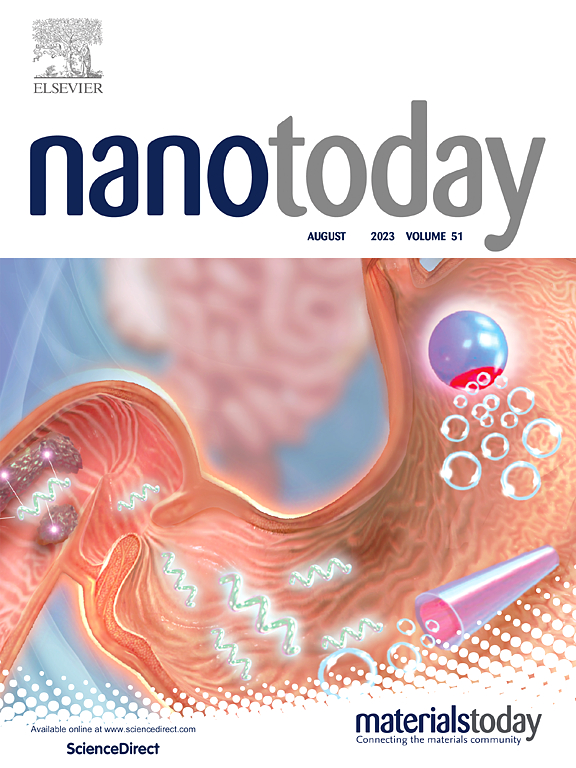双能量剥夺抑制胰腺癌进展的有效纳米策略
IF 13.2
1区 材料科学
Q1 CHEMISTRY, MULTIDISCIPLINARY
引用次数: 0
摘要
胰腺癌是一种对公众健康构成重大威胁的高度恶性肿瘤,而糖酵解在其能量代谢中起着至关重要的作用。本文利用 130 例胰腺导管腺癌(PDAC)患者的临床样本,证实糖酵解与预后不良直接相关,并进一步验证了锌离子(Zn2+)抑制糖酵解相关基因的有效性。因此,研究人员开发了聚乙烯吡咯烷酮(PVP)修饰的纳米硫化锌药物(ZnS-PVP),通过靶向胰腺癌的糖酵解和线粒体呼吸实现双能抑制。一方面,释放的 Zn2+ 可通过 PI3K-Akt-mTOR-HIF-1α 信号轴有效抑制胰腺癌细胞的糖酵解。另一方面,酸反应释放的硫化氢(H2S)气体会损伤线粒体,并通过抑制氧化磷酸化进一步降低能量补偿。这种双管齐下的能量剥夺纳米策略有效地消灭了胰腺癌细胞,并被证明可以克服化疗耐药性。此外,ZnS-PVP 给药与免疫检查点阻断(ICB)疗法相结合,可显著抑制小鼠正位胰腺肿瘤模型的肿瘤进展,这在胰腺癌患者异种移植(PDX)模型中也得到了证实。我们的工作凸显了生物活性金属离子在靶向肿瘤能量代谢方面的积极作用,以及纳米能量剥夺策略在胰腺癌治疗中的巨大潜力。本文章由计算机程序翻译,如有差异,请以英文原文为准。
A potent nano-strategy for dual energy deprivation to inhibit pancreatic cancer progression
Pancreatic cancer is a highly malignant tumor that poses significant threats to public health, and glycolysis plays a crucial role in its energy metabolism. Here, glycolysis was confirmed to be directly associated with poor prognosis through the use of clinical samples from 130 patients with pancreatic ductal adenocarcinoma (PDAC), and the effectiveness of zinc ions (Zn2+) in inhibiting glycolysis-related genes was further validated. Therefore, polyvinyl pyrrolidone (PVP)-modified zinc sulfide nanomedicines (ZnS-PVP) were developed for dual energy suppression by targeting glycolysis and mitochondrial respiration in pancreatic cancer. On the one hand, the released Zn2+ efficiently inhibited glycolysis in pancreatic cancer cells through the PI3K-Akt-mTOR-HIF-1α signaling axis. On the other hand, acid-responsive release of hydrogen sulfide (H2S) gas damaged mitochondria and further reduced energy compensation by inhibiting oxidative phosphorylation. This two-pronged energy deprivation nano-strategy effectively eliminated pancreatic cancer cells and was proven to overcome chemotherapeutic resistance. Moreover, ZnS-PVP administration combined with immune checkpoint blockade (ICB) therapy significantly suppressed tumor progression in mouse orthotopic pancreatic tumor models, as also demonstrated in a pancreatic cancer patient-derived xenograft (PDX) model. Our work highlights the positive role of bioactive metal ions in targeting tumor energy metabolism and the great potential of nano-strategy for energy deprivation in the treatment of pancreatic cancer.
求助全文
通过发布文献求助,成功后即可免费获取论文全文。
去求助
来源期刊

Nano Today
工程技术-材料科学:综合
CiteScore
21.50
自引率
3.40%
发文量
305
审稿时长
40 days
期刊介绍:
Nano Today is a journal dedicated to publishing influential and innovative work in the field of nanoscience and technology. It covers a wide range of subject areas including biomaterials, materials chemistry, materials science, chemistry, bioengineering, biochemistry, genetics and molecular biology, engineering, and nanotechnology. The journal considers articles that inform readers about the latest research, breakthroughs, and topical issues in these fields. It provides comprehensive coverage through a mixture of peer-reviewed articles, research news, and information on key developments. Nano Today is abstracted and indexed in Science Citation Index, Ei Compendex, Embase, Scopus, and INSPEC.
 求助内容:
求助内容: 应助结果提醒方式:
应助结果提醒方式:


